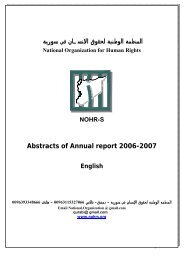התנהגויות אזרחיות והתנהגויות לא נאותות המנגנונים המסבירים שרד החינוך
התנהגויות אזרחיות והתנהגויות לא נאותות המנגנונים המסבירים שרד החינוך
התנהגויות אזרחיות והתנהגויות לא נאותות המנגנונים המסבירים שרד החינוך
You also want an ePaper? Increase the reach of your titles
YUMPU automatically turns print PDFs into web optimized ePapers that Google loves.
Ehrhart, M. G., & Naumann, S. E. (2004). Organizational citizenship behavior in work<br />
groups: A group norms approach. Journal of Applied Psychology, 89, 960-974.<br />
Frayne, C. A., & Latham, G. P. (1987). Application of social learning theory to employee<br />
self-management of attendance. Journal of Applied Psychology, 72, 387–392.<br />
Goddard, R.D. (2001). Collective efficacy: a neglected construct in the study of schools and<br />
student achievement. Journal of Educational Psychology, 93 (3), 467-76.<br />
Greenberg, J.(1990). Organizational justice: yesterday, today, and tomorrow. Journal of<br />
management, 16(2), 399-432.<br />
Greenberg, J., & Scott, K. S. (1996). Why do workers bite the hands that feed them?<br />
Employee theft as a social exchange process. In: B. M. Staw, & L. L. Cummings<br />
(Eds.), Research in organizational behavior, 18, 111–155. Greenwich, CT: JAI Press.<br />
Gruys, M.L., & Sackett, P.R. (2003). Investigating the dimensionality of counterproductive<br />
work behavior. International Journal of Selection and Assessment, 11(1), 30-42.<br />
Gully, S. M., Incalcaterra, K. A., Joshi, A., & Beaubien, J. M. (2002). A meta-analysis of<br />
team-efficacy, potency, and performance: Interdependence and level of analysis as<br />
moderators of observed relationships. Journal of Applied Psychology, 87, 819–832.<br />
Henle, C.A., Giacalone, R.A. & Jurkiewicz, C.L. (2005). The role of ethical ideology in<br />
workplace deviance. Journal of Business Ethics, 56 (3), 219-230.<br />
Hoy, W. K., Sweetland, S. R., & Smith, P. A. (2002). Toward an organizational model of<br />
achievement in high schools: The significance of collective efficacy. Educational<br />
Administration Quarterly, 38(1), 77-93.<br />
Kanter, R. M. (1983). The change masters: Innovation for productivity in the American<br />
corporation. New York: Simon & Schuster.<br />
Klein, J. & Weiss, I. (2007). Towards an integration of intuitive and systematic decision<br />
making in education. Journal of Educational Administration, 45(3), 265-277.<br />
Koslowsky, M. (1991). A longitudinal analysis of job satisfaction, commitment, and intention<br />
to leave. Applied Psychology: An International Review , 40, 405-415<br />
Krausz, M., Koslowsky, M., Shalom, N ,.Elyakim, N. (1995 ).Predictors of intentions to leave<br />
the ward, the hospital, and the nursing profession: a longitudinal study .Journal of<br />
Organisational Behaviour, 16 (3), 277-288.<br />
LePine, J. A., Erez, A., & Johnson, D. E. (2002). The nature and dimensionality of<br />
organizational citizenship behavior: A critical review and meta-analysis. Journal of<br />
Applied Psychology, 87(1), 52-65.<br />
14









